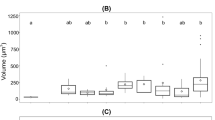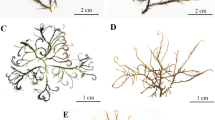Summary
This paper provides an overview of polymorphism in the colonial green alga,Scenedesmus, since discovery of this phenomenon over eighty years ago. Evidence is presented showing that the genus, as now generally considered, can be naturally sub-divided into two distinct groups which may be considered as separate genera. The extent of morphological variability in each group is discussed with particular attention given to the better-known, spine-bearing strains. Problems created by inclusion of both stable and unstable strains in the same taxon, as well as the complexity possible when variation in wall ornamentation is superimposed on colony-unicell transformations, are discussed. Data are presented showing that morphological type can be manipulated at will in some strains by careful control of nutrients. Experiments involving field incubations and laboratory studies using river water as a culture medium indicate that natural nutrient levels can regulate morphology and that polymorphic strains may be useful in providing assay organisms for assessment of water quality. Suggestions are offered as to how polymorphic strains, which have been ignored in all monographs to date, can be incorporated into a workable taxonomic scheme.
Zusammenfassung
Diese Arbeit gibt einen Uberblick über den Polymorphismus der kolonienbildenden Grünalge,Scenedesmus, seit Entdeckung dieses Phänomens vor über 80 Jahren. Beweise werden aufgeführt, die zeigen, dass derGenus, in seiner jetzt allgemein akzeptierten Form, unterteilt werden kann in zwei distinkte Gruppen, die als getrennteGenera betrachtet werden können. Das Ausmass der morphologischen Variabilität in jeder Gruppe wird diskutiert unter besonderer Beachtung der bekannteren, stacheltragenden Stämme. Die Probleme, die durch Einschluss von stabilen und instabilen Stämmen in dasselbeTaxon entstehen, werden diskutiert, sowohl als die Komplikationen, die möglicherweise entstehen, wenn Variationen der WandOrnamentik über die Kolonie-Einzelzell Transformation gestellt werden. Befunde werden vorgelegt die zeigen, dass in einigen Stmmen die morphologischen Typen durch vorsichtige Kontrolle der Nährstoffe manipuliert werden können. Experimente, bestehend aus Freiland Inkubationen und Laboratoriums Untersuchungen unter Verwendung von Flusswasser als Kulturmedium, weisen dauraufhin, dass in der Natur die Nährstoffmengen die Morphologie regulieren können, und weiterhin, dass polymorphe Stämme als Testorganismen nützlich sein könnten zur Feststellung der Wasserqualität. Vorschläge werden unterbreitet, wie polymorphe Stämme, die bisher in allen Monographien ignoriert worden sind, in ein arbeitsfähiges taxonomisches Schema inkorporiert werden können.
Similar content being viewed by others
References
Bailey, D. and Samsel, G. 1971. Bibliography on the ecology and taxonomy of fresh-water algae. IN: Rosowski, J. and B. Parker (Eds), Selected Papers in Phycology. Dept. Botany, Univ. Nebraska, Lincoln, pp 5–11.
Chodat, R. 1913. Monographies d’algues en culture pure. Materiaux pour la flore cryptogamique Suisse4: 1–266, Berne.
Chodat, R. 1926.Scenedesmus. Etude de genetique, de systematique experimentale et d’hydrobiologie. Rev. Hydrobiol.3: 71–258.
Chodat, R. et O. Malinesco. 1893. Sur le polymorphise deScenedesmus acutus. Bull. Herb. Boiss.1: 184–190.
Conway, K. and F. Trainor. 1972.Scenedesmus morphology and flotation. J. Phycology.8: 138–43.
Pringsheim, E. G. 1967. Phycology in the field and in the laboratory. J. Phycol.3: 93–95.
Shubert, L. E. and F. Trainor. 1974.Scenedesmus morphogenesis. Control of the unicell stage with phosphorus. Brit. Phycol. J.8: 1–7.
Smith, G. M. 1916. A monograph of the algal genusScenedesmus based upon pure culture studies. Trans. Wisc. Acad. Sci, Arts, Letters.18: 422–530.
Stein, J. 1973. Handbook of phycological methods. Culture methods and growth measurements. Cambridge Univ. Press. 448 pp.
Swale, E. 1967. A clone ofScenedesmus with Chodatella-stages. Br. Phycol. Bull.3: 281–93.
Trainor, F. 1965. A study of unialgal cultures ofScenedesmus indubated in nature and in the laboratory. Can. J. Bot.43: 701–5.
Trainor, F. 1969.Scenedesmus morphogenesis. Trace elements and spine formation. J. Phycol.5: 185–90.
Trainor, F. 1971. Development of form inScenedesmus. IN Parker, B. and M. Brown (Eds), Contributions in Phycology. p. 81–92. Allen Press, Lawrence, Kansas.
Trainor, F. and C. A. Burg. 1965.Scenedesmus obliquus sexuality. Science.148: 1094–1095.
Trainor, F. and F. Roskosky. 1967. Control of unicell formation in a soilScenedesmus. Can. J. Bot.45: 1657–1664.
Trainor, F., H. Rowland, J. Lylis, P. Winter and P. Bonanomi. 1971. Some examples of polymorphism in algae. Phycologia10: 113–119.
Trainor, F. and L. E. Shubert. 1974.Scenedesmus morphogenesis. Colony control in dilute media. J. Phycol.10: 28–30.
Uherkovich, G. 1966. Die Scenedesmus-Arten Ungarns. Academiai Kiado, Budapest.
Author information
Authors and Affiliations
Rights and permissions
About this article
Cite this article
Trainor, F.R., Cain, J.R. & Shubert, L.E. Morphology and nutrition of the colonial green algaScenedesmus: 80 years later. Bot. Rev 42, 5–25 (1976). https://doi.org/10.1007/BF02860860
Issue Date:
DOI: https://doi.org/10.1007/BF02860860




